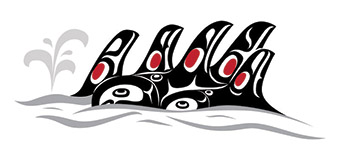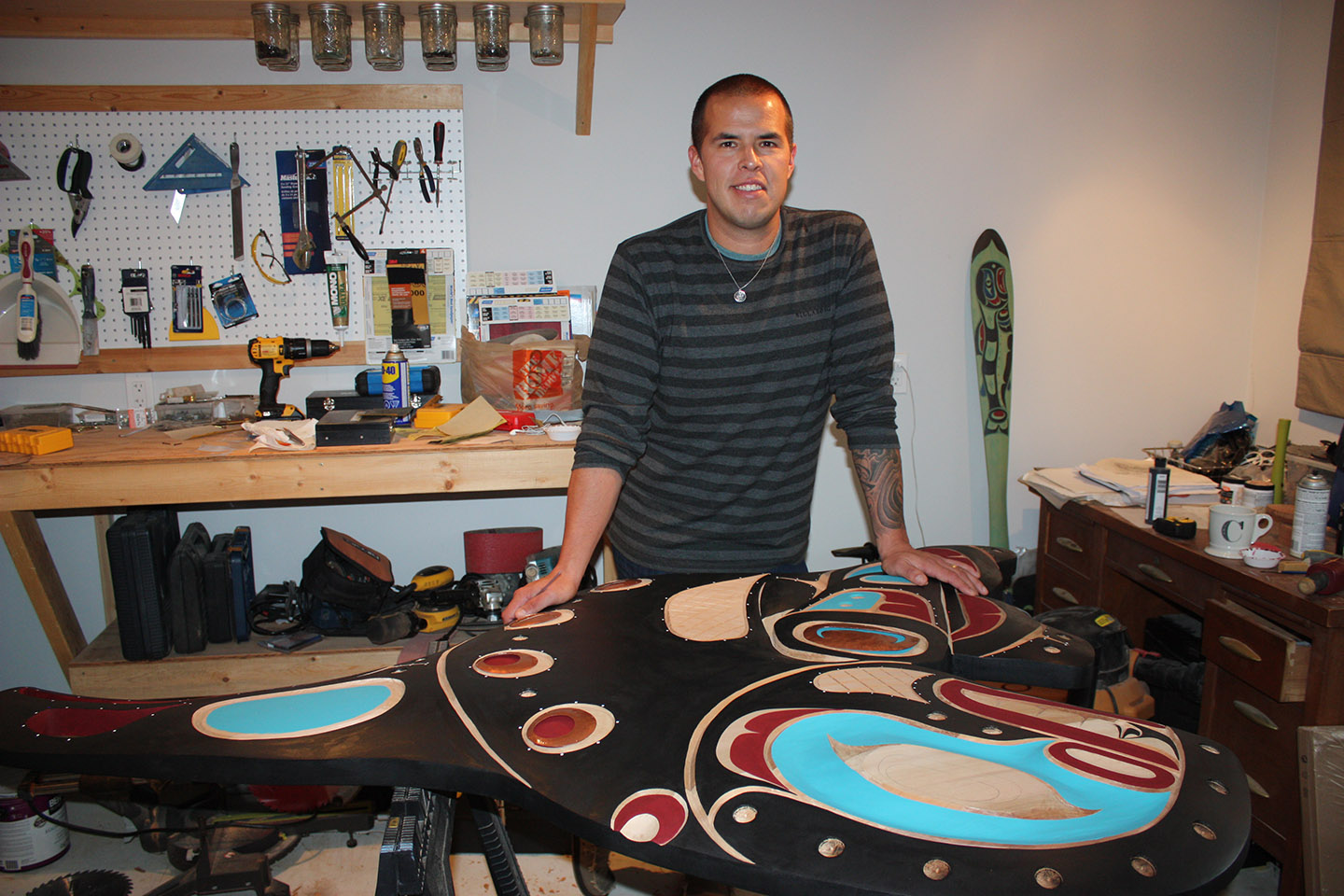Local band councillor keeps busy making art in what little downtime he has
Curtis Wilson says that while art is definitely in his blood, he didn’t always feel it coursing through him.
“I started fairly late, I would say. I didn’t really get into it until I was 18 or 19,” he says. “It was just something to do when I was away at college. It sort of grounded me, being away from Campbell River, as a reminder of where I come from.”
But it’s not a surprise that art showed up in his life, even if it did take a while for it to take hold.
“My artistic side comes from my mom’s side of the family,” he smiles. “She’s a Henderson.”
That’s a name people will recognize if they are at all familiar with First Nations art from around these parts. Sam Henderson, Wilson’s great uncle, is somewhat of a legend of First Nations art in our region.
His awe-inspiring, iconic totem poles still dot the landscape of the region and his carvings, masks, talking sticks and other works are found throughout the world in both public and private collections, including prominent placement at the Museum at Campbell River.
“I didn’t directly learn from him – I was about two years old when he passed away – but I learned from his children, my uncles, so I feel like I’ve learned from him,” Wilson says. “I try to take bits and pieces from each one of them and incorporate it into a style of my own without veering too far from the traditional styles that were instilled in them.”
But it’s not a ‘job’. Wilson says he’s never seen art as a way to make a living.
“I think that would sort of take the fun out of it,” he says. “Art is sort of my passion instead of a job. I do it during whatever time I can find.”
And that’s not much.
Besides his full-time job as a Referrals Officer with Nanwakolas Council, who represent eight First Nations from Comox up to Port Hardy and then spanning over onto the mainland, and act as the middle person between the Province and those Nations, “for anything from logging to mining to commercial recreation,” Wilson says, he also sits as an elected council member of the Campbell River Indian Band.
Oh, and he sits on the board of directors of the Campbell River Art Gallery.
And the Chamber of Commerce.
And the Museum at Campbell River.
And he’s involved with the Young Professionals of Campbell River, an organization devoted to the promotion of local economic development, community involvement, skill development and social interaction among under-45 professionals in the area.
But thankfully, Wilson can do without much sleep.
“I can get by on a couple of hours,” he laughs.
“I’m a morning person. I put in a half-day before most people are even out of bed, most of the time.”
He also doesn’t want art to become a job. He’s been there, done that.
For a while he was working with various galleries to sell his art, but he found it became too much about marketing and promotion and not enough about the actual art itself.
So now he works privately. Rather than making a ton of art and have it sitting around waiting for someone to fall in love with it, he takes orders for custom artwork, once piece at a time.
And that seems to be working.
“Right now, I’m finding it’s just one thing after another,” he says. “I’ll finish the piece I’m working on right now and have another one to get started on right after.”
While he will occasionally step back from commissioned work and do something purely from his own inspiration, “about once or twice a year,” he likes the collaborative process of working alongside someone who has a vision he can help them achieve.
“It feels like you’re both creating something together,” he smiles.
“I’m pretty open in that regard. I mean, there are certain things I need to stick by to keep it traditional,” he says, but admits there haven’t been people asking for things that aren’t what he likes to do anyway, because if they’re coming to him in the first place, it’s his previous work that has caused them to make that call.
Take the piece he was working on this fall, for example.
“It’s a killer whale panel,” he says. “It’s about four and a half feet by six feet, and they knew what they wanted in terms of colours, and they’ve had input in it right through the process.”
While wood carving is still his primary artistic medium, he has also been branching more and more into design and illustrative work.
He designed one of the new salmon banners that went up this past summer in Campbellton as part of a Campbellton Neighbourhood Association initiative to beautify the area, for example, and he recently finished a mural on the wall of a portable at L’École Mer-et-Montagne. He also designed two of the images now seen on the Campbell River Home Depot exterior accent walls.
And when he can, he makes art for fundraisers and various charities.
“I always tell people I’m happy to help out,” he says. “I get calls all the time about donations. I tend to do designs and get reproduction prints made and donate them,” he says, adding that he used to do carvings when people would ask, “but I’ve sort of stepped back from that. At one stage I was trying to do carvings for everyone that was asking for them, but it just got overwhelming.”
The concept of giving back, his branching out into illustrative work, along with his work with the CRIB recently led him to create Ba’buk’Sila’tsu Colouring Book, a book filled with First Nations artwork just waiting for colour, in collaboration with Kask Graphics here in Campbell River.
“Education is really important,” he says. In the work he does for the CRIB, education and culture are two of his portfolios.
He’s in his third term on the CRIB council, heading into his ninth year.
“Over those nine years, I’ve definitely tried to not only instill our culture within our own community, but also the outside community,” he says, and this is another way he can pursue that effort.
“It’s great, because it not only exposes them to our artwork, but also has our language, as well.”
Under each line drawing in the colouring book – one on each page – the word for what is pictured is written in Kwakw’ala, along with a pronunciation guide in English.
Then in the back of the book, there is an appendix that describes the symbols and what they mean in their culture. And apparently, people are loving them.
“I’ve already had to put in another order,” he laughs, “and it’s only been out for about a week, which is awesome.”
One thing Wilson likes most about the colouring book is that he gets to “see what everybody else sees in the designs.”
“There are a ton of different ways to imagine the colours going on the page,” he says, “and it’s fun to see what people’s artistic views are and what their visions are for how the colours should go into the artwork.”

It’s still too early to tell what the future holds for the colouring book, but based on the response, he has hopes that it could end up being used within the school system, for example, “to maybe become part of the tools they use, but we’ll have to see.”
Does that mean mass production? Huge distribution deals? Well, Wilson isn’t getting ahead of himself.
“I like to keep things local, as much as I can,” he says. “A lot of people are telling me I should go get it published (from a major publisher), but I like the fact that it’s me doing it and it’s a local printing company that’s doing it.”
And it’s not like he’s making money off it.
“It’s just cool to think that people are getting something of benefit out of it,” he says. “If I can break even on it, that’s really all I want.”
So basically he’s a local boy doing interesting and important local work, creating art with other local people to make a difference locally, just to be doing it.
Like his art itself, that’s something to be admired and appreciated.
